Neo-futurism
Neo-futurism is a late-20th- to early-21st-century movement in the arts, design, and architecture. It has been seen as a departure from the attitude of post-modernism and represents an idealistic[2] belief in a better future.
.png) Nanjing International Youth Cultural Centre, a neo-futuristic skyscraper in Nanjing, China[1] | |
| Years active | 1960s–present |
|---|---|
| Major figures | Peter Cook, Cedric Price, Renzo Piano, Richard Rogers, Norman Foster, Santiago Calatrava, Zaha Hadid |
| Influences | Futurism, high-tech architecture |
| Influenced | Parametricism |
Described as an avant-garde movement,[3] as well as a futuristic rethinking of the thought behind aesthetics and functionality of design in growing cities, the movement has its origins in the mid-20th-century structural expressionist work of architects such as Alvar Aalto and Buckminster Fuller.[2]
Futurist architecture began in the 20th century starting with styles such as Art Deco and later with the Googie movement as well as high-tech architecture.
Origins
Beginning in the late 1960s and early 1970s by architects such as Buckminster Fuller[4] and John C. Portman Jr.;[5][6][7] architect and industrial designer Eero Saarinen,[8] Archigram, an avant-garde architectural group (Peter Cook, Warren Chalk, Ron Herron, Dennis Crompton, Michael Webb and David Greene, Jan Kaplický and others);[9][10][11] [12][13][14] it is considered in part an evolution out of high-tech architecture, developing many of the same themes and ideas.[15]
Although it was never built, the Fun Palace (1961) interpreted by architect Cedric Price as a "giant neo-futurist machine"[16][17] influenced other architects, notably Richard Rogers and Renzo Piano, whose Pompidou Centre extended many of Price's ideas.
Definition
Neo-futurism was revitalised in 2007 after the publication of "The Neo-Futuristic City Manifesto"[18][19][20] included in the candidature presented to the Bureau International des Expositions (BIE)[21] and written by innovation designer Vito Di Bari [22][23] (a former executive director at UNESCO),[24] to outline his vision for the city of Milan at the time of the Universal Expo 2015. Di Bari defined his neo-futuristic vision as the "cross-pollination of art, cutting edge technologies and ethical values combined to create a pervasively higher quality of life"; [25] he referenced the Fourth Pillar of Sustainable Development Theory[26] and reported that the name had been inspired by the United Nations report Our Common Future.[27]
Jean-Louis Cohen has defined neo-futurism[28][29] as a corollary to technology, noting that a large amount of the structures built today are byproducts of new materials and concepts about the function of large-scale constructions in society. Etan J. Ilfeld wrote that in the contemporary neo-futurist aesthetic "the machine becomes an integral element of the creative process itself, and generates the emergence of artistic modes that would have been impossible prior to computer technology."[30] Reyner Banham's definition of "une architecture autre" is a call for an architecture that technologically overcomes all previous architectures but possessing an expressive form,[31] as Banham stated about neo-futuristic "Archigram's Plug-in Computerized City, form does not have to follow function into oblivion."[32]
In art and architecture
Neo-futurism was inspired partly by Futurist architect Antonio Sant'Elia and pioneered from the early 1960s and the late 1970s by Hal Foster,[33] with architects such as William Pereira,[34][35] Charles Luckman[36][37] and Henning Larsen.[38].
People
The relaunch of neo-futurism in the 21st century has been creatively inspired by the Pritzker Architecture Prize-winning architect Zaha Hadid,[39] architect Santiago Calatrava[40][41].
Neo-futurist architects, designers and artists include people like Denis Laming,[42][43][44] Patrick Jouin,[45] Yuima Nakazato,[46][47]artist Simon Stålenhag[48] and artist Charis Tsevis.[49][50][51] Neo-futurism has absorbed some high-tech architectural themes and ideas, incorporating elements of high-tech industry and technology іnto building design: Technology and context has been a focus for some architects such as Buckminster Fuller, Norman Foster,[52][53] Kenzo Tange, Renzo Piano and Richard Rogers.[41]
Gallery
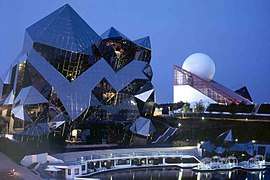 The Pavilions of Futuroscope in Poitiers by Denis Laming, 1984
The Pavilions of Futuroscope in Poitiers by Denis Laming, 1984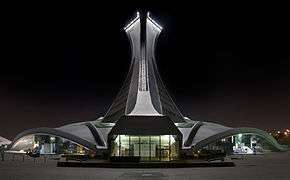
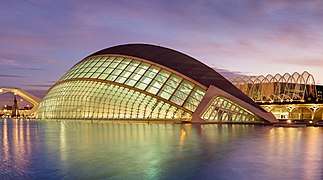
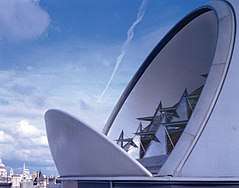 The British Library of Political and Economic Science in London by Norman Foster, 2000
The British Library of Political and Economic Science in London by Norman Foster, 2000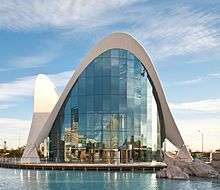 L'Oceanogràfic in the City of Arts and Sciences, Valencia by Félix Candela, 2003
L'Oceanogràfic in the City of Arts and Sciences, Valencia by Félix Candela, 2003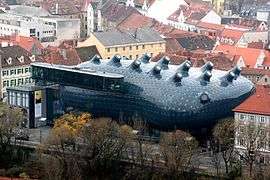
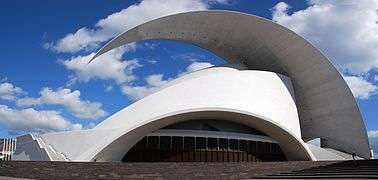 Auditorio de Tenerife in Santa Cruz de Tenerife by Santiago Calatrava, 2003
Auditorio de Tenerife in Santa Cruz de Tenerife by Santiago Calatrava, 2003_(472712279).jpg) El Palau de les Arts Reina Sofía in the City of Arts and Sciences, Valencia by Santiago Calatrava, 2005
El Palau de les Arts Reina Sofía in the City of Arts and Sciences, Valencia by Santiago Calatrava, 2005- The Turning Torso in Malmö by Santiago Calatrava, 2005
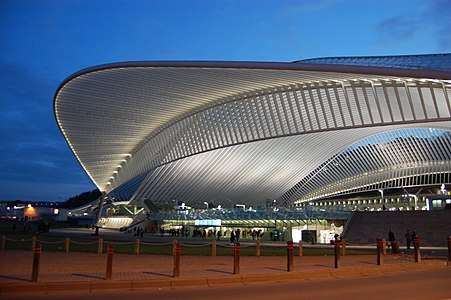 Liège-Guillemins railway station in Liège by Santiago Calatrava, 2009
Liège-Guillemins railway station in Liège by Santiago Calatrava, 2009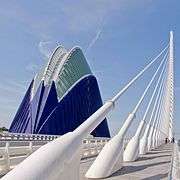 L'Àgora in the City of Arts and Sciences, Valencia by Santiago Calatrava, 2009
L'Àgora in the City of Arts and Sciences, Valencia by Santiago Calatrava, 2009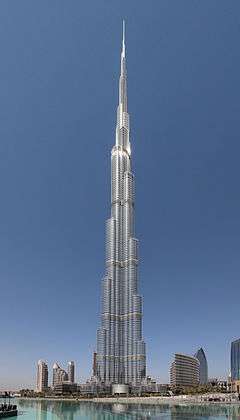
- Iceberg Palace in Sochi by Andrey Bokov, 2012
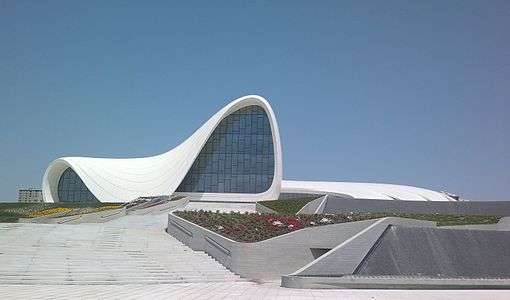 Heydar Aliyev Cultural Center in Baku by Zaha Hadid, 2012
Heydar Aliyev Cultural Center in Baku by Zaha Hadid, 2012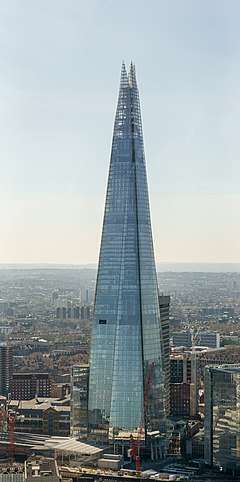
- Jockey Club Innovation Tower in Hong Kong by Zaha Hadid, 2013
.jpg)
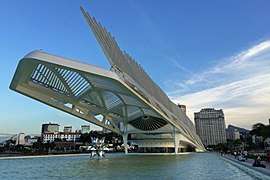 Museum of Tomorrow in Rio de Janeiro by Santiago Calatrava, 2015
Museum of Tomorrow in Rio de Janeiro by Santiago Calatrava, 2015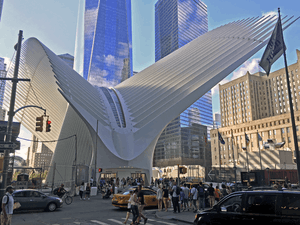 The World Trade Center Hub in New York City by Santiago Calatrava, 2016
The World Trade Center Hub in New York City by Santiago Calatrava, 2016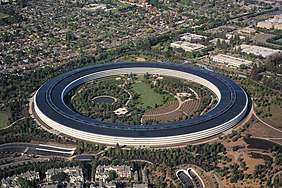 Aerial view of Apple Park in Cupertino by Norman Foster, 2017
Aerial view of Apple Park in Cupertino by Norman Foster, 2017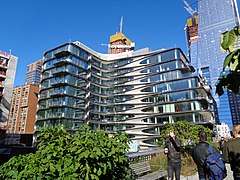 520 West 28th Street in New York City by Zaha Hadid, 2017
520 West 28th Street in New York City by Zaha Hadid, 2017
References
- https://robbreport.com/travel/hotels/jumeirah-nanjing-zaha-hadid-last-project-2860876/
- "Neo-futurism". designingbuildings.
- "Neo-futurism: An Overview for Students in Architecture Training". digitalschool.ca.
- Mathieu Lehanneur. "Mathieu Lehanneur recommends". Ted.com. Retrieved 22 October 2014.
- Kristi York Wooten. "How 1980s Atlanta Became the Backdrop for the Future". The Atlantic.
- "John portman News, Videos, Reviews and Gossip - io9". io9.
- "Silver Screen: Meet John Portman, the Architect Behind the Dystopian Backdrops of The Walking Dead and The Hunger Games". Yahoo News. 6 April 2015.
- "Big dreams and angry protests swirl at abandoned Athens airport". Uk.reuters.com. Retrieved 22 October 2014.
- ""Jan Kaplický" Video - Buildings and Interviews". OVGuide. Archived from the original on 2017-07-09. Retrieved 2015-05-09.
- "If Famous Buildings And Paintings Made Babies, They'd Look Like This". Co.Design. Retrieved 22 October 2014.
- Christie Chu (14 September 2014). "Imagining the Artist-Architect Collabos That Never Were". artnet News. Retrieved 22 October 2014.
- "Amstel Art Gallery London Archivio Marco Lodola Pop Art Design". Amstel Art Gallery London Archivio Marco Lodola Pop Art Design. Retrieved 22 October 2014.
- "ASIA CONTEMPORARY ART - Amstel Art Gallery". Asiacontemporaryart.com. Archived from the original on 22 October 2014. Retrieved 22 October 2014.
- "In Brief - Fiera Milano News". Fieramilanonews.it. Retrieved 22 October 2014.
- "neo-futurism". designingbuildings.
- Anthony Vidler (2008). "Histories of the immediate present: inventing architectural modernism" (PDF). MIT Press, Massachusetts Institute of Technology. Archived from the original (PDF) on 27 May 2014. Retrieved 22 October 2014.
- Erskine Design. "Frieze Magazine - Archive - The Enclosure Business". Frieze.com. Archived from the original on October 22, 2014. Retrieved 22 October 2014.
- "Archived copy". Archived from the original on October 17, 2014. Retrieved November 7, 2014.CS1 maint: archived copy as title (link)
- "Archived copy". Archived from the original on November 7, 2014. Retrieved November 7, 2014.CS1 maint: archived copy as title (link)
- "From Manifesto to Futurist Architecture". Worldarchitecture.org. Retrieved 22 October 2014.
- "BIE - Bureau International des Expositions". bie-paris.org.
- "MoreArtCulture Messenger: Vito Di Bari on Wednesday and Your Week in Arts + Culture". constantcontact.com.
- "The economic renaissance led by the Internet of Things". I-cioc.om. Retrieved 22 October 2014.
- "Agreement between UNESCO and the City of Milan concerning the International Multimedia Institute (IMI) - Appointment of Executive Director - UNESCO Archives ICA AtoM catalogue". Atom.archives.unesco.org. 1999-10-08. Retrieved 2014-01-17.
- Manifesto of Neo-Futuristic City in www.neofuturistic.com
- "The Concept Of "Sustainable Development" And The Challenges Of Economic Growth And Development In Nigeria". Katsina-Ala Multidisciplinary Journal. Retrieved 22 October 2014.
- World Commission on Environment and Development (1987). Our Common Future. Oxford: Oxford University Press. p. 27. ISBN 019282080X
- "The Future of Architecture Since 1889". Cool Hunting. Archived from the original on 22 October 2014. Retrieved 22 October 2014.
- "Blume Library Mobile". Library.stmarytx.edu. Retrieved 22 October 2014.
- "Beyond Contemporary Art: Amazon.co.uk: Etan Ilfeld: Books". Amazon.co.uk. Retrieved 22 October 2014.
- Reyner Banham: Historian of the Immediate Future (Cambridge: MIT Press, 2002)
- Reyner Banham, "A Clip-on Architecture," Architectural Design 35, no. 11
- "Neofuturism Architecture And Technology, SCI-Arc Media Archive". Sma.sciarc.edu. 1987-10-05. Retrieved 2014-01-17.
- Los Angeles Forum for architecture and urban design, Scott Johnson http://laforum.org/content/articles/william-pereira-by-scott-johnson Archived 2014-01-11 at the Wayback Machine
- The Los Angeles Chapter of The American Institute for Architects, Alan Hess, William Pereira: Designing Modern Los Angeles, 2013 http://www.aialosangeles.org/calendar/architect-william-pereira-s-modern-la#.UvA2D78TuqQ Archived 2014-11-29 at the Wayback Machine
- Hugh Pearman, Airports: A Century of Architecture, https://www.amazon.com/Airports-Century-Architecture-Hugh-Pearman/dp/081095012X
- http://www.preservationdallas.org/wp-content/uploads/2013/02/December-2012-Member-Newsletter.pdf
- "Sydney Opera House, Sydney - SkyscraperPage.com". skyscraperpage.com.
- "ឯកសារសំខាន់! ស្វែងយល់ពីស្ថាបត្យករអង់គ្លេសដើមកំណើតអ៉ីរ៉ាក់ លោកស្រី Zaha Hadid (មាន Video Clip)". Village of Wonder. Archived from the original on 18 May 2014. Retrieved 22 October 2014.
- "Spotlight: Santiago Calatrava". ArchDaily. Retrieved 22 October 2014.
- "Santiago Calatrava". Mediander. Archived from the original on 30 June 2017. Retrieved 22 October 2014.
- "Denis Laming Architectes". laming.fr. Archived from the original on 2016-04-22. Retrieved 2015-03-17.
- "Archived copy". Archived from the original on April 2, 2015. Retrieved March 17, 2015.CS1 maint: archived copy as title (link)
- Nicola Williams; Virginie Boone (2002). The Loire. Lonely Planet. pp. 47–. ISBN 978-1-86450-358-6.
- "King of good times". Indiatoday.intoday.in. Retrieved 22 October 2014.
- "Japanese Fashion Designer Literally Flexes Muscles with 3D Printing". Stratasys Blog. Retrieved 22 October 2014.
- "Yuima Nakazato creates neo-futuristic sportswear with an Objet500 Connex multi-material 3D Printer [7559] - Prototyp". Netcommunity.se. Archived from the original on 17 September 2013. Retrieved 22 October 2014.
- "Swedish seventies neoretrofuturism: the paintings of Simon Stålenhag". Boingboing.net. Retrieved 22 October 2014.
- "Archived copy". Archived from the original on November 7, 2014. Retrieved November 7, 2014.CS1 maint: archived copy as title (link)
- Paul Caridad. "Neofuturistic Vectors and Vibrant Mosaics". Visual News. Archived from the original on 2014-11-07. Retrieved 2014-11-07.
- "Tsevis Visual Design". Tsevis.soup.io. Retrieved 22 October 2014.
- "Lord Norman Foster". Encyclopædia Britannica. Retrieved 22 October 2014.
- "My Gallery Space 『・・・・ノ、セカイ』". Geocities.jp. Archived from the original on 5 November 2018. Retrieved 22 October 2014.
Further reading
- Cohen, Jean-Louis (2012). The Future of Architecture. Since 1889. London: Phaidon Press. ISBN 978-0714845982.
- Di Bari V. (2007). "100 years: From Manifesto of futurist architecture to the Neofuturistic city manifesto" (PDF). Retrieved 2015-04-18.
- Foster, Hal (1987). "Neo-Futurism: Architecture and Technology". AA Files. Architectural Association School of Architecture. 14: 25–27. JSTOR 29543561.
- Foster, Hal (1994). "What's Neo about the Neo-Avant-Garde?". October. MIT Press. 70: 5–32. JSTOR 779051.
- Rowena Easton, The NeoFuturist Manifesto, 2008 http://www.neofuturist.org/manifesto.php
- Klein, Caroline; Lieb, Stefanie (2013). Futuristic: Visions of Future Living. Cologne: DAAB Media. ISBN 978-3942597098.
- A History of Neo-Futurism, Erica Anne Milkovich, 2010 - Avant-garde (Aesthetics)
- Gunther Berghaus, From Futurism to Neo-Futurism, in Avant-garde/Neo-avant-garde, 2005, published by Dietrich Scheunemann, Rodopi BV https://web.archive.org/web/20140811220127/http://www.rodopi.nl/senj.asp?BookId=Avant+17
- Colin Rowe, Fred Koetter, After the Millennium, in Collage City, 1983, published by Architecture - The MIT Press, Cambridge, MA
- Etan Jonathan Ilfeld, Beyond Contemporary Art, 2012, Vivays Publishing, London
- Anthony Vidler, Histories of the immediate present, 2008 MIT Press, Massachusetts Institute of Technology ISBN 978-0-262-72051-9
- Reyner Banham, “A Clip-on Architecture,” Architectural Design 35, no. 11
- Reyner Banham: Historian of the Immediate Future (Cambridge: MIT Press, 2002)
- Ru Brown, FUTURISM IS DEAD LONG LIVE FUTURISM The legacy of techno-love in contemporary design, 2011, University of Washington - MDes Design Investigations
- Gabriel Gyang Dung, Bridget Mlumun Akaakohol, J.C. Akor - The Concept Of Sustainable Development And The Challenges Of Economic Growth And Development In Nigeria - July 2014, Department of Economics, College of Education, Katsina-Ala.